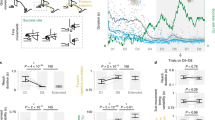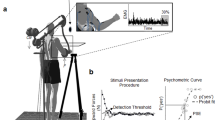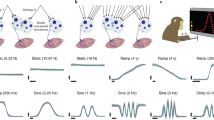Abstract
A hallmark of the human motor system is its ability to adapt motor patterns for different environmental conditions, such as when a skilled ice-hockey player accurately shoots a puck with or without protective equipment. Each object (stick, shoulder pad, elbow pad) imparts a distinct load upon the limb, and a key problem in motor neuroscience is to understand how the brain controls movement for different mechanical contexts1,2. We addressed this issue by training non-human primates to make reaching movements with and without viscous loads applied to the shoulder and/or elbow joints, and then examined neural representations in primary motor cortex (MI) for each load condition. Even though the shoulder and elbow loads are mechanically independent, we found that some neurons responded to both of these single-joint loads. Furthermore, changes in activity of individual neurons during multi-joint loads could be predicted from their response to subordinate single-joint loads. These findings suggest that neural representations of different mechanical contexts in MI are organized in a highly structured manner that may provide a neural basis for how complex motor behaviour is learned from simpler motor tasks.
This is a preview of subscription content, access via your institution
Access options
Subscribe to this journal
Receive 51 print issues and online access
$199.00 per year
only $3.90 per issue
Buy this article
- Purchase on Springer Link
- Instant access to full article PDF
Prices may be subject to local taxes which are calculated during checkout




Similar content being viewed by others
References
Wolpert, D. M. & Ghahramani, Z. Computational principles of movement neuroscience. Nature Neurosci. 3 suppl., 1212–1217 (2000)
Wolpert, D. M. & Kawato, M. Multiple paired forward and inverse models for motor control. Neural Netw. 11, 1317–1329 (1998)
Shadmehr, R. & Mussa-Ivaldi, F. A. Adaptive representation of dynamics during learning of a motor task. J. Neurosci. 14, 3208–3224 (1994)
Kalaska, J. F., Cohen, D. A., Hyde, M. L. & Prud'homme, M. A comparison of movement direction-related versus load direction-related activity in primate motor cortex, using a two-dimensional reaching task. J. Neurosci. 9, 2080–2102 (1989)
Gandolfo, F., Li, C., Benda, B. J., Schioppa, C. P. & Bizzi, E. Cortical correlates of learning in monkeys adapting to a new dynamical environment. Proc. Natl Acad. Sci. USA 97, 2259–2263 (2000)
Kalaska, J. F., Scott, S. H., Cisek, P. & Sergio, L. E. Cortical control of reaching movements. Curr. Opin. Neurobiol. 7, 849–859 (1997)
Porter, R. & Lemon, R. Corticospinal Function and Voluntary Movement (Oxford Univ. Press, Oxford, 1995)
Ashe, J. Force and the motor cortex. Behav. Brain Res. 87, 255–269 (1997)
Scott, S. H. Apparatus for measuring and perturbing shoulder and elbow joint positions and torques during reaching. J. Neurosci. Methods 89, 119–127 (1999)
Scott, S. H., Gribble, P. L., Graham, K. M. & Cabel, D. W. Dissociation between hand motion and population vectors from neural activity in motor cortex. Nature 413, 161–165 (2001)
Humphrey, D. R. & Reed, D. J. in Motor Control Mechanisms in Health and Disease Advances in Neurology no. 39 (ed. Desmedt, J.) 347–372 (Raven, New York, 1983)
Fetz, E. E., Cheney, P. D., Mewes, K. & Palmer, S. in Peripheral Control of Posture and Locomotion (eds Allum, J. A. H. & Hulliger, M.) 437–449 (Elsevier, New York, 1989)
Cabel, D. W., Cisek, P. & Scott, S. H. Neural activity in primary motor cortex related to mechanical loads applied to the shoulder and elbow during a postural task. J. Neurophysiol. 86, 2102–2108 (2001)
Sanes, J. N. & Schieber, M. H. Orderly somatotopy in primary motor cortex: does it exist? Neuroimage 13, 968–974 (2001)
McKiernan, B. J., Marcario, J. K., Karrer, J. H. & Cheney, P. D. Corticomotorneuronal postspike effects in shoulder, elbow, wrist, digit, and intrinsic hand muscles during a reach and prehension task. J. Neurophysiol. 80, 1961–1980 (1998)
Imamizu, H. et al. Human cerebellar activity reflecting an acquired internal model of a new tool. Nature 403, 192–195 (2000)
Wolpert, D. M., Miall, R. C. & Kawato, M. Internal models in the cerebellum. Trends Cogn. Sci. 2, 338–347 (1998)
Schmidt, R. A. & Wrisbert, C. A. Motor Learning and Performance: A Problem-Based Learning Approach (Human Kinetics, Champaign, 2000)
Wightman, D. C. & Lintern, G. Part-task training for tracking and manual control. Hum. Factors 27, 267–283 (1985)
Scott, S. H. & Kalaska, J. F. Reaching movements with similar hand paths but different arm orientations. I. Activity of individual cells in motor cortex. J. Neurophysiol. 77, 826–852 (1997)
Gribble, P. L. & Scott, S. H. Method for assessing directional characteristics of non-uniformly sampled neural activity. J. Neurosci. Methods 113, 187–197 (2002)
Loeb, G. E. & Gans, C. Electromyography for Experimentalists (Univ. Chicago Press, Chicago, 1986)
Acknowledgements
We thank K. Moore for technical assistance, and D.W. Cabel and S. Chan who assisted in some of the training and neuronal recording sessions. We thank D. Munoz, M. Pare and K. Rose for comments on this manuscript. This work was supported by a CIHR grant and scholarship (S.H.S.) and a CIHR postdoctoral fellowship (P.L.G.).
Author information
Authors and Affiliations
Corresponding author
Ethics declarations
Competing interests
S.H.S. holds a US patent for the robotic device used in these experiments.
Rights and permissions
About this article
Cite this article
Gribble, P., Scott, S. Overlap of internal models in motor cortex for mechanical loads during reaching. Nature 417, 938–941 (2002). https://doi.org/10.1038/nature00834
Received:
Accepted:
Issue Date:
DOI: https://doi.org/10.1038/nature00834
This article is cited by
-
A robot-aided visuomotor wrist training induces motor and proprioceptive learning that transfers to the untrained ipsilateral elbow
Journal of NeuroEngineering and Rehabilitation (2023)
-
The speed of adaptation is dependent on the load type during target reaching by intact human subjects
Experimental Brain Research (2021)
-
European association of endoscopic surgeons (EAES) consensus statement on the use of robotics in general surgery
Surgical Endoscopy (2015)
-
Multi-compartment model can explain partial transfer of learning within the same limb between unimanual and bimanual reaching
Experimental Brain Research (2009)
-
Motor imagery and action observation: cognitive tools for rehabilitation
Journal of Neural Transmission (2007)
Comments
By submitting a comment you agree to abide by our Terms and Community Guidelines. If you find something abusive or that does not comply with our terms or guidelines please flag it as inappropriate.



